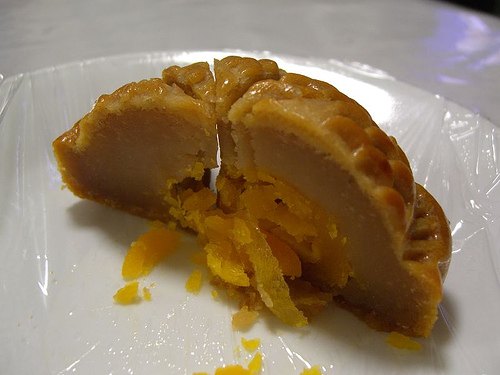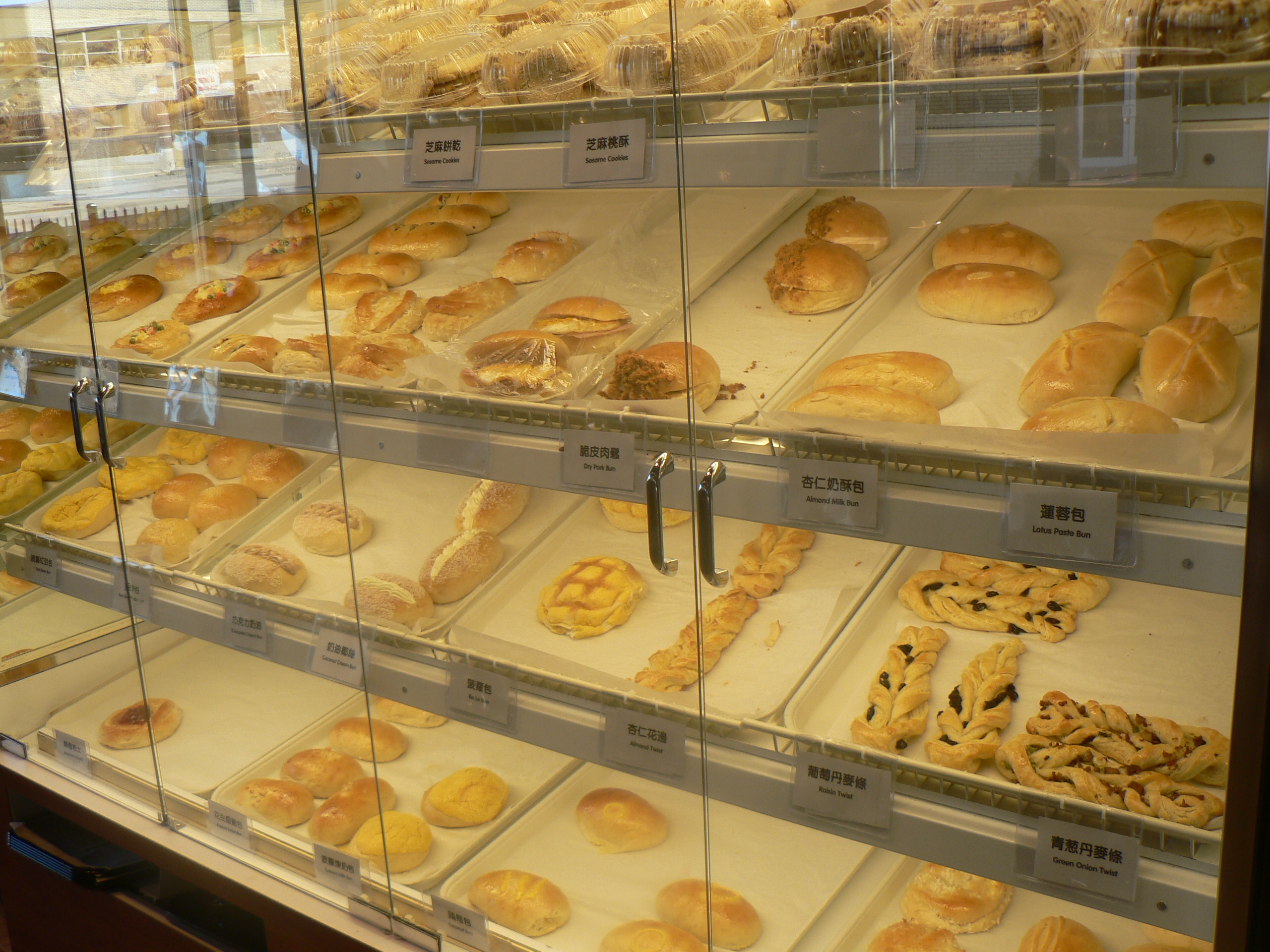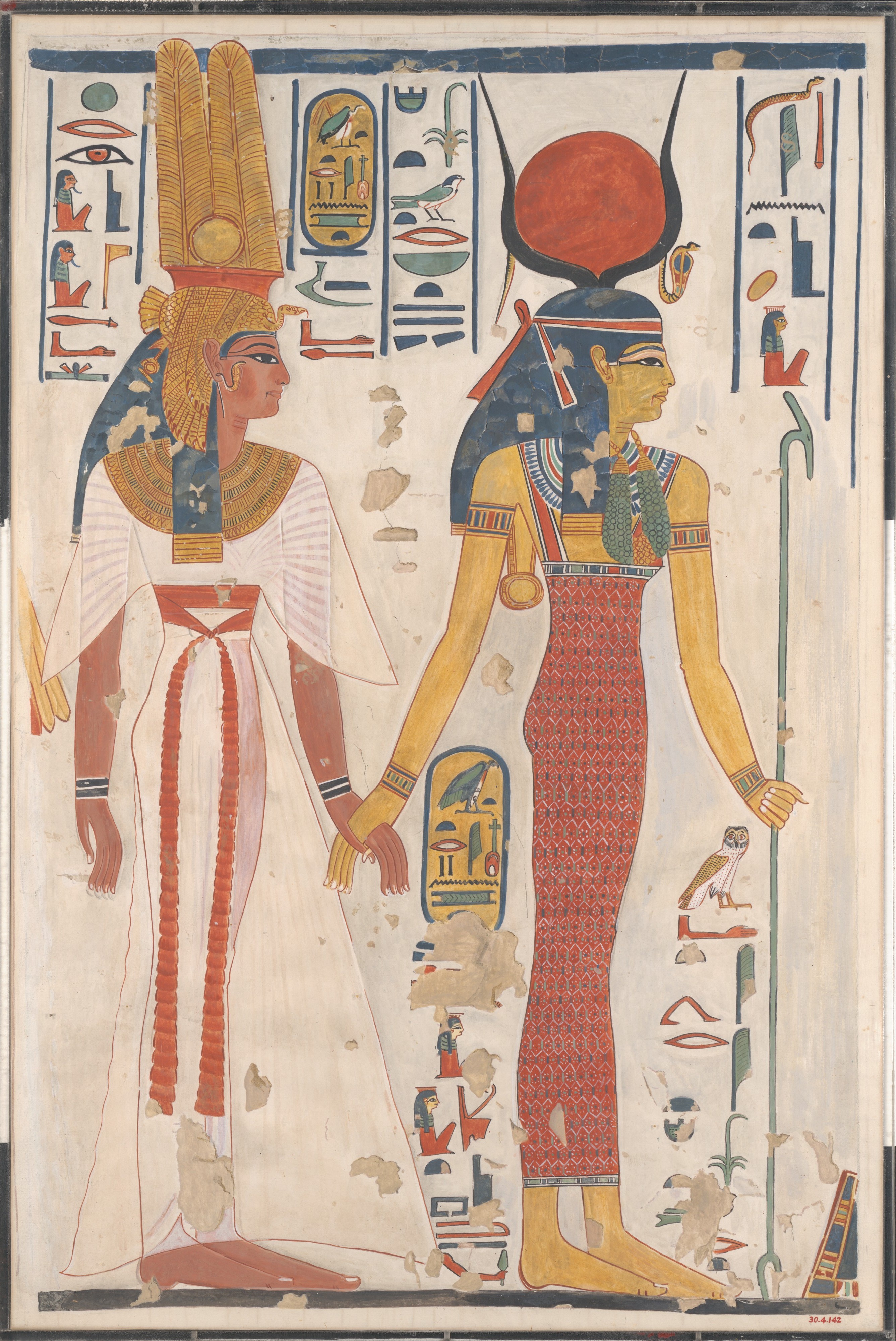|
Mooncake
A mooncake () is a Chinese bakery product traditionally eaten during the Mid-Autumn Festival (中秋節). The festival is primarily about the harvest while a legend connects it to moon watching, and mooncakes are regarded as a delicacy. Mooncakes are offered between friends or on family gatherings while celebrating the festival. The Mid-Autumn Festival is widely regarded as one of the four most important Chinese festivals. There are numerous varieties of mooncakes consumed within China and outside of China in overseas Chinese communities. The Cantonese mooncake is the most famous variety. A traditional Cantonese mooncake is a round pastry, measuring about in diameter and thick, with a rich, thick filling usually made from lotus seed paste (other typical fillings include red bean paste or mixed nuts) surrounded by a thin, 2–3 mm (approximately 1/8 of an inch) crust and may contain yolks from salted duck eggs. Mooncakes are usually eaten in small wedges, accom ... [...More Info...] [...Related Items...] OR: [Wikipedia] [Google] [Baidu] |
Mid-Autumn Festival
The Mid-Autumn Festival (for other names, see § Etymology) is a harvest festival celebrated in Chinese culture. It is held on the 15th day of the 8th month of the Chinese lunisolar calendar with a full moon at night, corresponding to mid-September to early October of the Gregorian calendar. On this day, the Chinese believe that the moon is at its fullest and brightest, coinciding with the time of harvest in the middle of autumn. The Mid-Autumn Festival is one of the most important holidays and celebrations in Chinese culture; its popularity is on par with that of Chinese New Year. The history of the festival dates back over 3,000 years. Similar festivals are celebrated by other cultures in East and Southeast Asia. During the festival, lanterns of all sizes and shapessymbolizing beacons that light the path toward prosperity and good fortune for the peopleare carried and displayed. Mooncakes, a traditionally rich pastry that is typically filled with sweet-bean or lotus-seed ... [...More Info...] [...Related Items...] OR: [Wikipedia] [Google] [Baidu] |
Red Bean Paste
Red bean paste () or red bean jam, also called adzuki bean paste or ''anko'' (a Japanese word), is a paste made of red beans (also called "adzuki beans"), used in East Asian cuisine. The paste is prepared by boiling the beans, then mashing or grinding them. At this stage, the paste can be sweetened or left as it is. The color of the paste is usually dark red, which comes from the husk of the beans. In Korean cuisine, the adzuki beans (often the black variety) can also be husked prior to cooking, resulting in a white paste. It is also possible to remove the husk by sieving after cooking, but before sweetening, resulting in a red paste that is smoother and more homogeneous. Etymology In Japanese, a number of names are used to refer to red bean paste; these include , and . Strictly speaking, the term ''an'' can refer to almost any sweet, edible, mashed paste, although without qualifiers red beans are assumed, while refers specifically to the paste made with red beans. Ot ... [...More Info...] [...Related Items...] OR: [Wikipedia] [Google] [Baidu] |
Lotus Seed Paste
Lotus seed paste is a Chinese dessert ingredient made from dried lotus seeds. It is traditionally considered a luxurious ingredient. Production The process for making the paste is similar to that of smooth red bean paste. First, the dried seeds are stewed in water until soft prior to being mashed into a fine paste. The paste is then watered down to a thin slurry and passed through a sieve and into cheesecloth, with which it is squeezed dry. This produces a fine crumbly paste, which is then mixed with sugar or other sweeteners and, often, oil to produce a smooth, sweet paste. Use China The lotus paste used by most Chinese cooks requires further preparation by dry cooking the sweetened paste over heat with caramelized sugar and vegetable oil. This produces a lotus paste that is tan in colour with a satiny sheen. It is also rich, sweet, silky with a slight fragrance of caramel. Some cooks choose to treat the dried lotus seeds with a lye solution before initially stewing them in or ... [...More Info...] [...Related Items...] OR: [Wikipedia] [Google] [Baidu] |
East Asia
East Asia is a geocultural region of Asia. It includes China, Japan, Mongolia, North Korea, South Korea, and Taiwan, plus two special administrative regions of China, Hong Kong and Macau. The economies of Economy of China, China, Economy of Japan, Japan, Economy of South Korea, South Korea, and Economy of Taiwan, Taiwan are among the world's largest and most prosperous. East Asia borders North Asia to the north, Southeast Asia to the south, South Asia to the southwest, and Central Asia to the west. To its east is the Pacific Ocean. East Asia, especially History of China, Chinese civilization, is regarded as one of the earliest Cradle of civilization#China, cradles of civilization. Other ancient civilizations in East Asia that still exist as independent countries in the present day include the History of Japan, Japanese, History of Korea, Korean, and History of Mongolia, Mongolian civilizations. Various other civilizations existed as independent polities in East Asia in the past ... [...More Info...] [...Related Items...] OR: [Wikipedia] [Google] [Baidu] |
Chinese Bakery Products
Chinese bakery products ( or ) consist of pastries, cakes, snacks, and desserts of largely Chinese origin, though some are derived from Western baked goods. Some of the most common "Chinese" bakery products include mooncakes, sun cakes (Beijing and Taiwan varieties), egg tarts, and wife cakes. Chinese bakeries are present in countries with ethnic Chinese people, and are particularly common in Chinatowns. The establishments may also serve tea, coffee, and other drinks. Bakery types There are regional differences in cities with large Chinese presences, particularly those in Asia like Singapore, Kuala Lumpur, Penang, Ipoh, Jakarta, Manila, and Bangkok. Bakery fillings especially may be influenced by Indonesia, Malaysia, the Philippines, or Thailand. In North America, the largest Chinatowns, such as San Francisco, Vancouver, New York, and Toronto, have the widest range of offerings, including influences from France, Italy, Japan, and Mexico. There are also large overlaps in the ... [...More Info...] [...Related Items...] OR: [Wikipedia] [Google] [Baidu] |
Pastry
Pastry refers to a variety of Dough, doughs (often enriched with fat or eggs), as well as the sweet and savoury Baking, baked goods made from them. The dough may be accordingly called pastry dough for clarity. Sweetened pastries are often described as ''Flour confections, baker's confectionery''. Common pastry dishes include pies, tarts, quiches, croissants, and Turnover (food), turnovers. The French word pâtisserie is also used in English (with or without the accent) for many of the same foods, as well as the set of techniques used to make them. Originally, the French word referred to anything, such as a meat pie, made in dough (''paste'', later ''pâte'') and not typically a luxurious or sweet product. This meaning still persisted in the nineteenth century, though by then the term more often referred to the sweet and often ornate confections implied today. Definitions The precise definition of the term pastry varies based on location and culture. Common doughs used to make ... [...More Info...] [...Related Items...] OR: [Wikipedia] [Google] [Baidu] |
Chang'e
Chang'e ( ; ), originally known as Heng'e (), is the goddess of the Moon and wife of Hou Yi, the great archer. Renowned for her beauty, Chang'e is also known for her ascending to the Moon with her pet Yu Tu, the Moon Rabbit and living in the Moon Palace (). She is one of the major goddesses in Chinese mythology, Chinese folk religion, Chinese Buddhism, Confucianism, and Taoism. In modern times, Chang'e is the namesake of the Chinese Lunar Exploration Program. Origins and descriptions Chang'e first appeared in '' Guicang'', a divination text written during the Zhou Dynasty (1046 BC – 256 BC). From the few preserved fragments of the text, it mentions "Yi shoots the ten Suns", and "Chang'e ascending to the moon." Chang'e—originally named —was renamed to avoid the taboo on sharing names with a deceased emperor, in this case, Liu Heng, an emperor from Han Dynasty. Many Chinese poems are written around the theme of Chang'e and the moon. In pre-Qin Dynasty (before 221 BC), ... [...More Info...] [...Related Items...] OR: [Wikipedia] [Google] [Baidu] |
Mythology
Myth is a genre of folklore consisting primarily of narratives that play a fundamental role in a society. For scholars, this is very different from the vernacular usage of the term "myth" that refers to a belief that is not true. Instead, the veracity of a myth is not a defining criterion. Myths are often endorsed by religious (when they are closely linked to religion or spirituality) and secular authorities. Many societies group their myths, legends, and history together, considering myths and legends to be factual accounts of their remote past. In particular, creation myths take place in a primordial age when the world had not achieved its later form. Origin myths explain how a society's customs, institutions, and taboos were established and sanctified. National myths are narratives about a nation's past that symbolize the nation's values. There is a complex relationship between recital of myths and the enactment of rituals. Etymology The word "myth" comes from Ancient ... [...More Info...] [...Related Items...] OR: [Wikipedia] [Google] [Baidu] |
Goddess
A goddess is a female deity. In some faiths, a sacred female figure holds a central place in religious prayer and worship. For example, Shaktism (one of the three major Hinduism, Hindu sects), holds that the ultimate deity, the source of all reality, is Mahadevi (Supreme Goddess) and in some forms of Tantric Shaivism, the pair of Shiva and Shakti are the ultimate principle (with the goddess representing the active, creative power of God). Meanwhile, in Vajrayana, Vajrayana Buddhism, ultimate reality is often seen as being composed of two principles depicted as two deities in union (Yab-Yum, yab yum, "father-mother") symbolising the non-duality of the two principles of perfect wisdom (female) and skillful compassion (male). A single figure in a monotheistic faith that is female may be identified simply as god because of no need to differentiate by gender or with a diminutive. An experiment to determine the effect of psychedelics on subjects composed of leaders from diverse religio ... [...More Info...] [...Related Items...] OR: [Wikipedia] [Google] [Baidu] |
Immortality
Immortality is the concept of eternal life. Some species possess "biological immortality" due to an apparent lack of the Hayflick limit. From at least the time of the Ancient Mesopotamian religion, ancient Mesopotamians, there has been a conviction that gods may be physically immortal, and that this is also a state that the gods at times offer humans. In Christianity, the conviction that God may offer physical immortality with the resurrection of the flesh at the end of time has traditionally been at the center of its beliefs. What form an unending human life would take, or whether an immaterial soul exists and possesses immortality, has been a major point of focus of religion, as well as the subject of speculation and debate. In religious contexts, immortality is often stated to be one of the promises of divinities to human beings who perform virtue or follow divine law. Some scientists, futurists and philosophers have theorized about the immortality of the human body, with ... [...More Info...] [...Related Items...] OR: [Wikipedia] [Google] [Baidu] |
Liji
The ''Book of Rites'', also known as the ''Liji'', is a collection of texts describing the social forms, administration, and ceremonial rites of the Zhou dynasty as they were understood in the Warring States and the early Han periods. The ''Book of Rites'', along with the ''Rites of Zhou'' () and the '' Book of Etiquette and Rites'' (), which are together known as the "Three Li ()," constitute the ritual () section of the Five Classics which lay at the core of the traditional Confucian canon (each of the "five" classics is a group of works rather than a single text). As a core text of the Confucian canon, it is also known as the ''Classic of Rites'' or ''Lijing'', which some scholars believe was the original title before it was changed by Dai Sheng. History The ''Book of Rites'' is a diverse collection of texts of uncertain origin and date that lacks the overall structure found in the other "rites" texts (the ''Rites of Zhou'' and the '' Etiquette and Ceremonial''). Some s ... [...More Info...] [...Related Items...] OR: [Wikipedia] [Google] [Baidu] |
Yuan Dynasty
The Yuan dynasty ( ; zh, c=元朝, p=Yuáncháo), officially the Great Yuan (; Mongolian language, Mongolian: , , literally 'Great Yuan State'), was a Mongol-led imperial dynasty of China and a successor state to the Mongol Empire after Division of the Mongol Empire, its division. It was established by Kublai (Emperor Shizu or Setsen Khan), the fifth khagan-emperor of the Mongol Empire from the Borjigin clan, and lasted from 1271 to 1368. In Chinese history, the Yuan dynasty followed the Song dynasty and preceded the Ming dynasty. Although Genghis Khan's enthronement as Khagan in 1206 was described in Chinese language, Chinese as the Han Chinese, Han-style title of Emperor of China, Emperor and the Mongol Empire had ruled territories including modern-day northern China for decades, it was not until 1271 that Kublai Khan officially proclaimed the dynasty in the traditional Han style, and the conquest was not complete until 1279 when the Southern Song dynasty was defeated in t ... [...More Info...] [...Related Items...] OR: [Wikipedia] [Google] [Baidu] |









